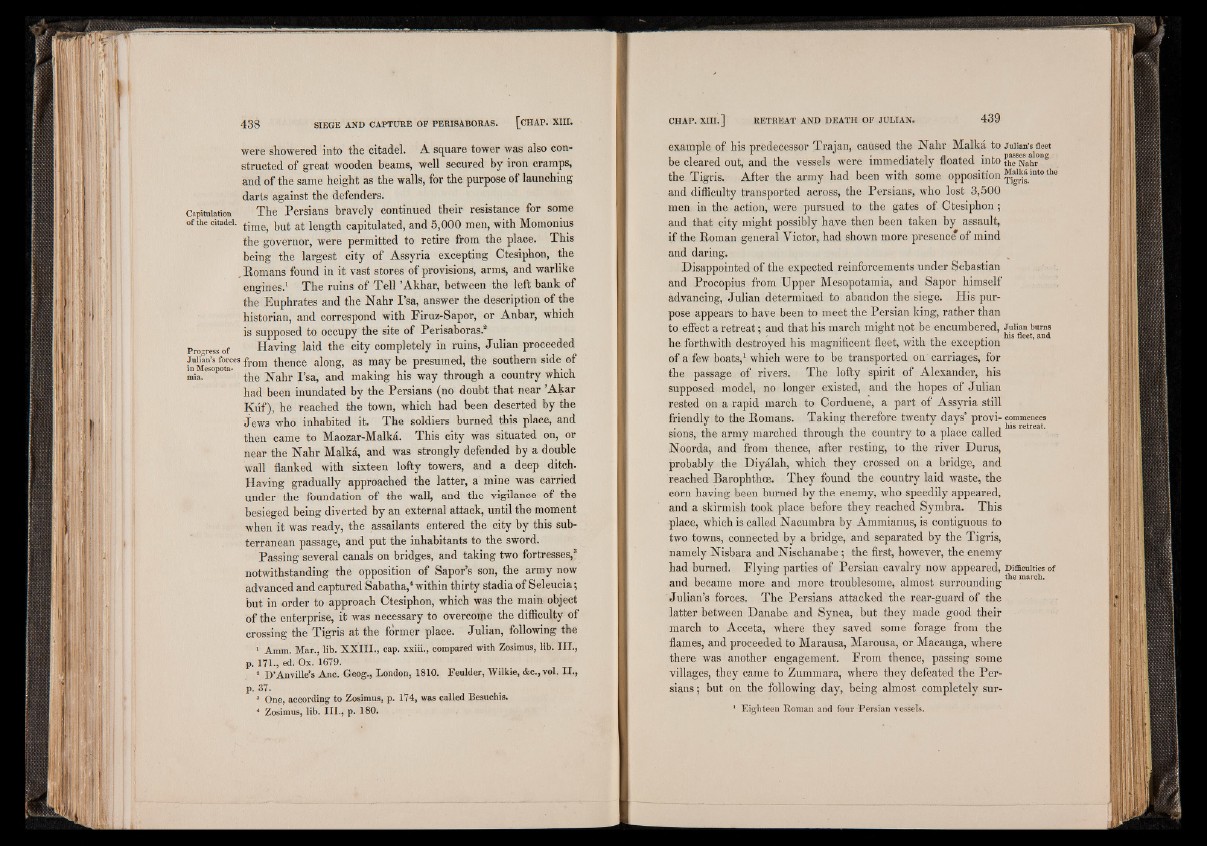
Capitulation
of the citadel.
Progress of
Julian’s fore«
in Mesopotamia.
were showered into the citadel. A square tower was also constructed
of great wooden beams, well secured by iron cramps,
and of the same height as the walls, for the purpose of launching
darts against the defenders.
The Persians bravely continued their resistance for some
time, but at length capitulated, and 5,000 men, with Momonius
the governor, were permitted to retire from the place. This
being the largest city of Assyria excepting Ctesiphon, the
. Romans found in it vast stores of provisions, arms, and warlike
engines.1 The ruins of Tell ’Akhar, between the left bank of
the Euphrates and the Nahr Psa, answer the description of the
historian, and correspond with Eiruz-Sapor, or Anbar, which
is supposed to occupy the site of Perisaboras.8
Having laid the city completely in ruins, Julian proceeded
1 from thence along, as may be presumed, the southern side of
the Nahr Psa, and making his way through a country which
had been inundated by the Persians (no doubt that near ’Akar
Kuf), he reached the town, which had been deserted by the
Jews who inhabited it. The soldiers burned this place, and
then came to Maozar-Malka. This city was situated on, or
near the Nahr Malka, and was strongly defended by a double
wall flanked with sixteen lofty towers, and a deep ditch.
Having gradually approached the latter, a mine was carried
under the foundation of the wall, and the vigilance of the
besieged being diverted by an external attack, until the moment
when it was ready, the assailants entered the city by this subterranean
passage, and put the inhabitants to the sword.
Passing several canals on bridges, and taking two fortresses,3
notwithstanding the opposition of Sapor’s son, the army now
advanced and captured Sabatha,4 within thirty stadia of Seleucia;
but in order to approach Ctesiphon, which was the main object
of the enterprise, it was necessary to overcoqie the difficulty of
crossing the Tigris at the former place. Julian, following the
1 Amm. Mar., lib. X X I I I ., cap. xxiii., compared with Zosimus, lib. I I I .,
p. 171., ed. Ox. 1679.
2 D ’Anville’s Anc. Geog., London, 1810. Feulder, Wilkie, &e., vol. I I .,
p. 37.
3 One, according to Zosimus, p. 174, was called Besuchis.
4 Zosimus, lib. I I I ., p. 180.
example of his predecessor Trajan, caused the Nahr Malka to Julian’s fleet
be cleared out, and the vessels were immediately floated intotheNahr”8
the Tigris. After the army had been with some opposition the
and difficulty transported across, the Persians, who lost 3,500
men in the action, were pursued to the gates of Ctesiphon;
and that city might possibly have then been taken by assault,
if the Roman general Victor, had shown more presence of mind
and daring.
Disappointed of the expected reinforcements under Sebastian
and Procopius from Upper Mesopotamia, and Sapor himself
advancing, Julian determined to abandon the siege. His purpose
appears to have been to meet the Persian king, rather than
to effect a retreat; and that his march might not be encumbered, Julian bums
he forthwith destroyed his magnificent fleet, with the exception
of a few boats,1 which were to be transported on carriages, for
the passage of rivers. The lofty spirit of Alexander, his
supposed model, no longer existed, and the hopes of Julian
rested on a rapid march to Corduene, a part of Assyria still
friendly to the Romans. Taking therefore twenty days’ provi- commences
sions, the army marched through the country to a place called ' •.
Noorda, and from thence, after resting, to the river Durus,
probably the Diyalah, which they crossed on a bridge, and
reached Barophthoe. They found the country laid waste, the
corn having been burned by the enemy, who speedily appeared,
and a skirmish took place before they reached Symbra. This
place, which is called Nacumbra by Ammianus, is contiguous to
two towns, connected by a bridge, and separated by the Tigris,
namely Nisbara and Nischanabe; the first, however, the enemy
had burned. Flying parties of Persian cavalry now appeared, Difficulties of
and became more and more troublesome, almost surrounding
Julian’s forces. The Persians attacked the rear-guard of the
latter between Danabe and Synea, but they made good their
march to Acceta, where they saved some forage from the
flames, and proceeded to Marausa, Marousa, or Macauga, where
there was another engagement. From thence, passing some
villages, they came to Zummara, where they defeated the Persians
; but on the following day, being almost completely sur-
* Eighteen Roman and four Persian vessels.